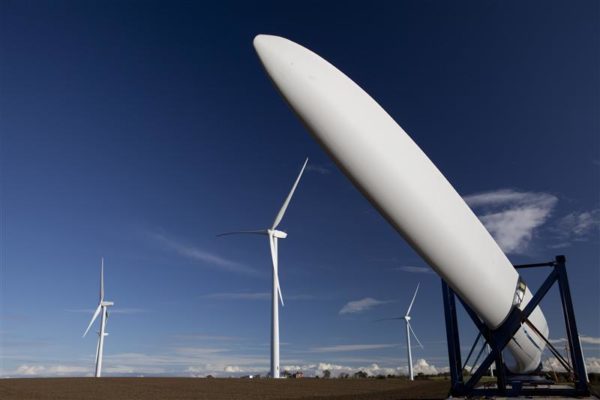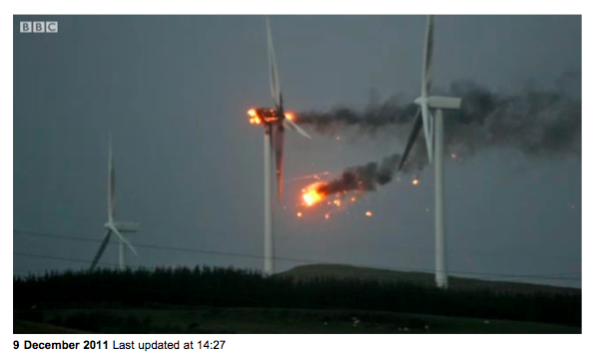Factcheck: How often do wind turbines break?
A spate of unfortunate news stories about wind power has put some observers in a spin

The year’s first bit of energy news involved some pointing and laughing at the wind energy sector following the collapse of a 200ft turbine in Northern Ireland — it was blown over by gusts that were classed as ‘medium’.
And, just days earlier, people were up in arms about offshore wind turbines sometimes using rather than generating energy.
Then, yesterday, a borders wind farm was shut down after it was thought a part fell off (turns out that didn’t happen).
In tandem, these events made for a pretty bad fortnight for UK wind — wind turbines break.
These sorts of things happen most years, inspiring blogs about the unreliability of Britain’s biggest source of renewable energy.
They are right that sometimes wind turbines fall over, and sometimes (more often) there are mechanical malfunctions that press pause on generation operations.
So, it’s worth asking how, how often, why, and is anything being done about it?

Fires and fallings over
The how and why of the fallen turbine at County Tyrone – one of eight at the Screggagh wind farm – is being formally investigated by German manufacturer Nordex.
It’s suspected that there was a break with the machine’s brakes, that the blades then span so fast the head became unhinged, and ultimately the whole thing came crashing down.
The only other time a UK turbine of comparable size fell down like this was more than seven years ago — in November 2007, a 660kw turbine of more than 200ft based in Argyll and Bute, Scotland “bent in half” during heavy winds, according to Renewable UK’s database.
Smaller turbines – like those owned by farmers and installed in fields – fall over more frequently, though not all too often either.
There was only one occurrence last year, and five others since the start of 2011 (plus a “controlled collapse” following wind damage). In that time three small turbines also lost blades.
And then there’s the big one, the very large wind turbine in North Ayrshire, Scotland that caught ablaze in 2011.
In the midst of a hurricane-force winds that also brought offline a nearby nuclear power station, the turbine’s gear box was ignited.
Renewable UK says this is a really rare occurrence, and there are officially only around 12 wind turbine fires reported a year worldwide.
There was a report last year from Imperial and Edinburgh University that claimed that figure is almost 10 times greater — 117— but its authors later said their findings were “misleading” and gave wind a clean bill of fire-health.
There’s 5951 wind turbines in the UK – both on and offshore – and apparently there’s never been an incident of this sort offshore.
Also, nobody has died or even been injured in these events. That’s not to say that people haven’t died doing wind energy — there have been three lives lost in the construction process and one in a maintenance accident.
Why isn’t that windmill spinning?
A Telegraph reader wrote to the paper late last year having observed offshore wind turbines along North Wales coast using grid energy to spin slightly in a bid to resist encroaching ice.
It’s true, though there are a few caveats for the little bits of energy used for de-icing and lighting; they are not always drawing from the grid on these occasions, but from neighbouring turbines; and other energy generators like nuclear, gas and coal also use small amounts of grid energy to stay running right.
So, how often are these turbines idle?
Either when there’s a maintenance issue to be resolved, when there’s no wind or when’s there’s too-strong winds — the machine’s brakes stop the spinning to prevent accidents like the one in Northern Ireland.
According to RWE, who runs the infamous grid-draining idle offshore farm in North Wales, there is a sophisticated computer that switches turbines on and off so to make the most of what’s there — taking into consideration wind speed, angle and host of other algorithmically determined variables.
Renewable UK says that, on average, wind turbines are generating electricity 70-80% of the time.
Old age turbines
You might also ask if deteriorating over time wind turbines produce less energy less efficiently.
The answer is yes. Wind turbines usually have a lifespan of 20-25 years and, according to research by Iain Staffell and Richard Green from Imperial College London, see their output (aka how much energy they generate) fall by 12% over those two decades.
This is down to the degradation of load factors (aka percentage of possible output) from around 28.5% when new to 21% at age 19 — this also increases the levelised cost of electricity.





